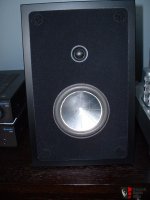I am designing a few smallish portable battery operated speakers (.25 cubic feet) and I am interested in passive radiators. I've caught on that many commercially available speakers use these to attempt to tune the cabinet lower, without an awkward, noisy port.
I was thinking about using something like this...
https://www.parts-express.com/dayton-audio-sd215-pr-8-passive-radiator--295-492
and then a 5" woofer tuned a bit high... say 60-70 hz.
Can anyone steer me toward a radiator/woofer combo that might work in .25 cubic feet?
Thanks so much!!
Tor
I was thinking about using something like this...
https://www.parts-express.com/dayton-audio-sd215-pr-8-passive-radiator--295-492
and then a 5" woofer tuned a bit high... say 60-70 hz.
Can anyone steer me toward a radiator/woofer combo that might work in .25 cubic feet?
Thanks so much!!
Tor
The Swiss made Pawel Acoustic Ensemble Reference speakers utilized a KEF PR mounted on the back of the speaker. The woofer was a unique Gorlich design that sported a pure cone shape (no dust cap) and foil-covered honeycomb sandwich constructed cone. Very fast response. The cabinet was stuffed to the max with fine Polyester fiber. I don't recall the exact KEF p/n for that PR but some searching should turn it up. It had an oval race track shape.
Attachments
Last edited:
You need to use a box program like UniBox - Unified Box Model for Loudspeaker Design, that has a Passive Radiator calculator. This will allow you to see how well the driver and PR will go together (F3, xmax and xmechanical in particular) and how much weight may need to be added to the PR.
Peerless has a couple of smaller PR's that when doubled up might also work for a small box application.
The Madisound Speaker Store
The Madisound Speaker Store
Peerless has a couple of smaller PR's that when doubled up might also work for a small box application.
The Madisound Speaker Store
The Madisound Speaker Store
Excellent thank you all so much. I am still a bit confused as to why these things don't admit canceling waves, like a a hole in the side of a speaker box would. My only answer is that the mass of the resonator delays the air push from the back side of the woofer enough to cause the resonator to oscillate in sync with the woofer. I've have a thread going on this topic, but I'm still not satisfied with its workings.
Very cool design for ultra compact speakers though~
T
Very cool design for ultra compact speakers though~
T
- Status
- Not open for further replies.

